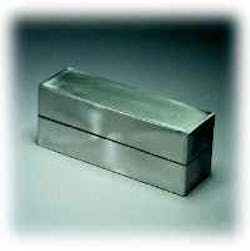Bond-and-release epoxy aims to shock
ElectRelease high-strength epoxy is sandwiched between metal substrates.
Applying between 10 and 50 V of electricity causes the epoxy to disbond, cleaving the "sandwich" into two pieces — one clean substrate and another with the epoxy still attached.
SHOPS MAY SOON DITCH CLUMSY fasteners and replace them with a new high-strength, electrically disbonding adhesive called ElectRelease. The epoxy bonds together metal substrates and withstands shear forces to 2,000 psi. Users simply apply 10 to 50 V of electricity to the bonded joint to separate the parts into one clean substrate and another with the epoxy still attached.
EIC Laboratories Inc. of Norwood, Mass., which developed ElectRelease, says that industries such as automotive, industrial equipment, and aerospace could use the epoxy in a number of applications — such as bonding fenders to automobiles or attaching temporary structures to aircraft (rather than drilling bolt holes in a wing or fuselage). The technology also holds promise for use in space, where it could replace the explosive mechanism often used to detach the components of a spacecraft or satellite. A major application involves holding workpieces steady for machining. Parts are easily separated once milling, turning, grinding, or other operations are complete.
Users of the low-voltage release mechanism need only a thin, light layer of the epoxy, offering a weight advantage over heavy conventional fasteners such as metal bolts.
To make the epoxy, users mix two separate chemicals, which come in a two-barrel tube that meters out the proper proportions. At room temperature, the mixed epoxy has a working life of 40 min, and it fully hardens in 24 hr. At elevated temperatures (approximately 175° F) hardening takes just an hour.
According to Dr. Stuart Cogan, EIC's vice president of advanced materials, EIC anticipates commercial opportunities for the technology throughout the Department of Defense and NASA as well as in private-sector launch vehicles and satellites. He says the company is continuing to refine its product and seek new markets and appropriate applications. "We would like to see a considerably shortened cure time for these epoxies so that they would be much more amenable to a high-volume manufacturing operation," says Cogan. He adds that once these refinements are made, it shouldn't be difficult to find a contractor to produce epoxies in large batches.
ElectRelease has been released as a commercial product, and Cogan expects to have a marketable, rapidcuring product within the next one to three years, at which time licensing of the technology will be a strong option.
